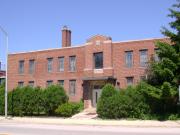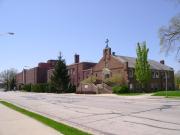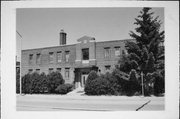| Additional Information: | A 'site file' exists for this property. It contains additional information such as correspondence, newspaper clippings, or historical information. It is a public record and may be viewed in person at the Wisconsin Historical Society, State Historic Preservation Office. This complex is comprised of the three following buildings: Our Lady of Mt. Carmel Church (1938-39, 6626 W. Beloit Road); the Sisters of Charity of St. Joan Antida Convent (1940, 6640 W. Beloit Road); and the Sisters of Charity of St. Joan Antida Home for the Aged (1948, 6670 W. Beloit Road). Beginning with the church, which is located at the easternmost end of the complex, the front-gabled, brick-faced, Romanesque Revival-influenced structure rests on a raised basement and is fronted by a walled staircase. The central, double-door entrance is set within a slightly projecting, stone surround; a single, round-arched window rests at either side of the doorway. Above the entry is a small rose window with modest tracery; a row of soldier brick separates the first level from the peak area. Brick pilasters with stone trim outline the primary facade on either side and additional short pilasters at the peak form a small belltower area which is surmounted by a stylized cross. The visible easterly side wall is divided into three bays by simple, brick, stone-capped piers; each of which carries rectilinear, double-hung windows along the basement level, while the main level features round-arched windows.
Adjacent to the church to the west is the 1940 convent, which rises two stories and is also sheathed with brick. The double-door entrance is located at the center of the symmetrically arranged facade and is topped by a transom and set within a simple stone surround. A flat, copper overhangs tops the entry, while a single window rests above, as does a stone inset that is inscribed with "INSTITUTION ST. JOAN ANTIDE." Brick, pier-like ornamentation frames the central bay and terminates in a gabled parapet. Rectangular, multiple-light windows line both the first and second levels, while simple brickwork and stone coping completes the wall's upper edge. Finally, the westernmost structure (1948) rises three stories and is also symmetrically arranged. A central entrance bay is trimmed with stone and is topped by a flat-roof overhang. A stone cross is incorporated into the entrance bay trim. The outermost edges of the structure display tall and narrow sections of glass block, while the remainder carries paired and singly arranged, rectangular sash windows.
Established in the early 1930s, the Our Lady of Mt. Carmel Society was formed by a group of West Allis Catholic Italians, led by Mr. Guiseppe LaBabera. This Italian-speaking group petitioned the Archbishop to establish a church for their approximately 250 members. Although the Archbishop concluded that the group could not support the construction of their own church, he did grant permission for the group to pursue rented quarters. For one year, they occupied a storefront on 63rd & Lapham streets; and, for the next few years they met at Holy Assumption Church at 7101 W. Orchard Street. Unbeknownst to the Archbishop, the group began gathering funds for the erection of a church and, in 1938, the subject site on W. Beloit Road was purchased and construction began, again, unbeknownst to the Archbishop. Prior to completion, the Archbishop learned of the progress through the newspaper and meetings were held thereafter in order to address the congregations breaking of Cannon Law. It was decided that the church would be turned over to the Archdiocese and the congregants would be responsible for the remaining $18,000 in debt. A priest would be sent when the church was completed and the Sisters of St. Joan Antida were asked to provide religious education for the children. The first service was held on 21 September 1939 and in October 1946, the church was designated as a mission to St. Rita's parish in Milwaukee (not West Allis). In 1940, the convent, designed by Herbst & Kuenzli, was built southwest of the church and, eight years later, the Home for the Aged was completed adjacent to the convent. In the early- to mid-1990s, the Sisters retired from teaching religious education and lay persons took over. In 1996, the church was considered for closure and, at the same time, the Sisters of Charity had announced that they were leaving the health care field. Final church services were held on 12 July 1998. The church building is now owned by Living Waters Christian Church, while the former convent and retirement home now serves as a group care home.
2019: Not Resurveyed - Nonextant. |
|---|



